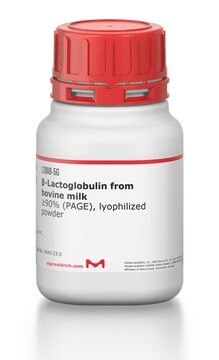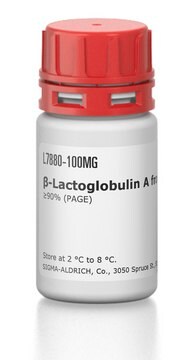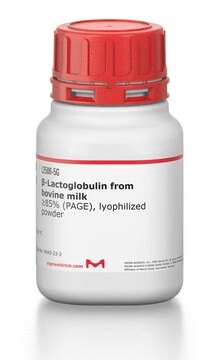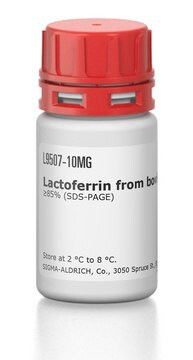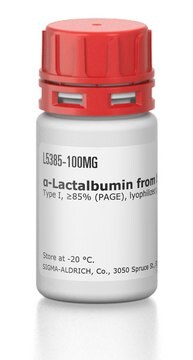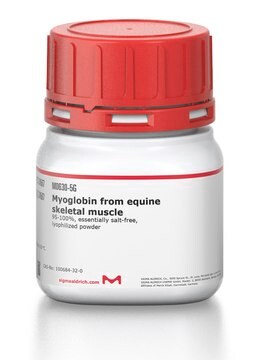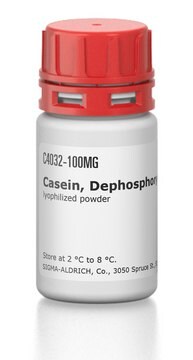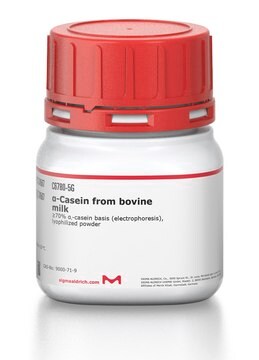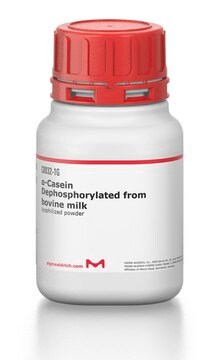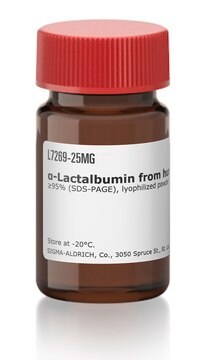L0130
β-Lactoglobulin aus Kuhmilch
≥90% (PAGE), lyophilized powder
Synonym(e):
β-LG, Bos d 5, beta-LG
Anmeldenzur Ansicht organisationsspezifischer und vertraglich vereinbarter Preise
Alle Fotos(2)
About This Item
Empfohlene Produkte
Biologische Quelle
bovine milk
Qualitätsniveau
Assay
≥90% (PAGE)
Form
lyophilized powder
UniProt-Hinterlegungsnummer
Lagertemp.
2-8°C
Angaben zum Gen
bovine ... LGB(280838)
Suchen Sie nach ähnlichen Produkten? Aufrufen Leitfaden zum Produktvergleich
Allgemeine Beschreibung
A member of the lipocalin family, β-Lactoglobulin (βLg) is a small protein of 162 amino acids with a molecular mass of ∼18,400 Da. It features an eight-stranded β-barrel (strands A-H) succeeded by a three-turn a-helix and a final β-strand (strand I) that forms part of the dimerization interface.
Milk from dairy cows contains the protein β-lactoglobulin (BLG). It naturally occurs in a number of genetic variants, and the most prevalent bovine variants are BLG A and BLG B.
Anwendung
β-Lactoglobulin from bovine milk was used to test the allergen-responsive CD4+ CD25+ regulatory T cells in children who have outgrown cow′s milk allergy. It is also used to test the competitive displacement of β-lactoglobulin by Tween 20 from oil-water and air-water interfaces.
Sonstige Hinweise
Contains β-lactoglobulins A and B which can be isolated chromatographically.
Qualität
May not contain folate binding protein; not recommended for folate analysis.
Angaben zur Herstellung
Crystallized
Lagerklassenschlüssel
11 - Combustible Solids
WGK
WGK 3
Flammpunkt (°F)
Not applicable
Flammpunkt (°C)
Not applicable
Persönliche Schutzausrüstung
Eyeshields, Gloves, type N95 (US)
Hier finden Sie alle aktuellen Versionen:
Besitzen Sie dieses Produkt bereits?
In der Dokumentenbibliothek finden Sie die Dokumentation zu den Produkten, die Sie kürzlich erworben haben.
Kunden haben sich ebenfalls angesehen
Janire Orcajo et al.
Analytica chimica acta, 1052, 163-169 (2019-01-28)
Immunochemical detection of food allergens is usually based on the use of polyclonal or monoclonal immunoglobulins G (IgG) antibodies. However, due to differences in epitopes recognition between IgG and IgE, an epitope modification during food processing can potentially alter allergenicity
The Competitive Displacement of ?-Lactoglobulin by Tween 20 from Oil-Water and Air-Water Interfaces
Peter J. Wilde, David C. Clark
Journal of Colloid and Interface Science, 155, 48-54 (1993)
Unni Haddeland et al.
Pediatric allergy and immunology : official publication of the European Society of Pediatric Allergy and Immunology, 16(2), 104-112 (2005-03-25)
The hygiene hypothesis implies that the increasing prevalence of allergy in 'westernized' countries is explained by reduced bacterial exposure in early life, but the underlying mechanism remains elusive. We therefore wanted to study the effect of bacterial lipopolysaccharide (LPS) on
A Heinzmann et al.
International archives of allergy and immunology, 120(4), 280-286 (2000-01-21)
beta-Lactoglobulin (BLG) represents one of the major allergens causing cow's milk allergy (CMA) - a disease with a wide spectrum of clinical symptoms. The aim of this study was to evaluate sequential B cell epitopes of BLG by the Pin-ELISA
Kristin R Domike et al.
International journal of biological macromolecules, 44(4), 301-310 (2009-05-14)
Proteins aggregated into spherulite structures of amyloid fibrils have been observed in patients with certain brain diseases such as Alzheimer's and Parkinson's. The conditions under which these protein spherulites form and grow are not currently known. In order to illuminate
Unser Team von Wissenschaftlern verfügt über Erfahrung in allen Forschungsbereichen einschließlich Life Science, Materialwissenschaften, chemischer Synthese, Chromatographie, Analytik und vielen mehr..
Setzen Sie sich mit dem technischen Dienst in Verbindung.